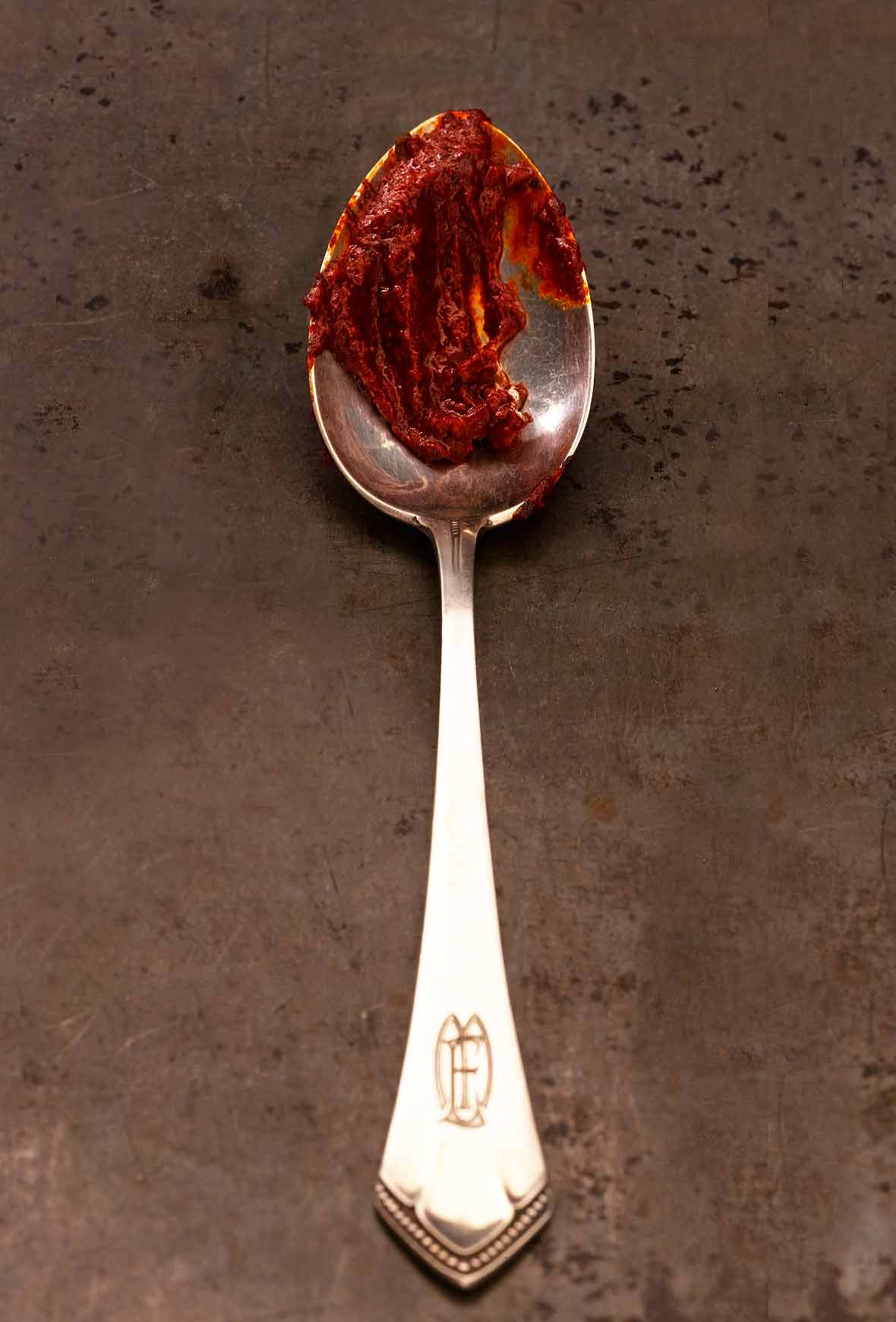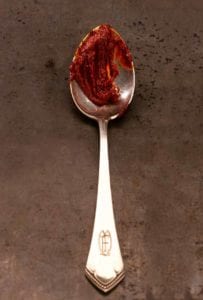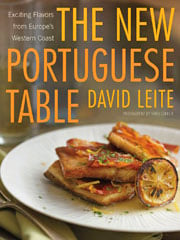
Massa de pimentão is originally from the Alentejo province. The salty red pepper paste, a pantry staple, is a Portuguese classic and constitutes the major flavor component of the region’s cooking. Each cook has his or her own version. Some are made from fresh bell peppers that have been salt-cured, others rely on roasted peppers, still, others turn to paprika. This isn’t the classic version. This is an “amped-up red pepper paste” based upon my family’s recipe. I wanted all the flavors of the Portuguese kitchen in one power punch of a paste.
It’s richly flavored–think of it as a preseasoned rub–so all you have to do to make dinner is rub a little on beef, chicken, fish, or even peeled, halved potatoes before roasting. Although I have to say that this particular paste’s most famous—and deservedly so—application (although granted, I’m a little biased) is my Grandmother Costa’s Bread Dressing.–David Leite
How To Use Portuguese Red Pepper Paste
David explains that red pepper paste is sorta like Asian fish sauce in that a little goes a loooooooong ways. As David mentions above, you can rub a little on a beef roast, chicken (both above and below the skin), fish, even peeled, halved potatoes before before roasting. Or you can stir it into stews or soups. It works wonders when stirred into mayo. And any other application you can imagine where you want or need a little bling. Then let us know how you used it in a comment below.

Portuguese Red Pepper Paste
Ingredients
- 2 tablespoons sweet paprika
- 2 tablespoons sweet smoked paprika
- 1/4 cup dry red wine
- 8 to 10 garlic cloves
- 2 Turkish bay leaves, crumbled
- 3 tablespoons tomato paste, or 1 tablespoon double-concentrate tomato paste
- 1 1/2 tablespoons fresh lemon juice
- 7 sprigs cilantro
- 5 sprigs flat-leaf parsley
- 1 1/2 tablespoons kosher salt (16 g)
- 1/4 teaspoon freshly ground white pepper
- Few dashes piri-piri sauce, or to taste
- 1/4 cup olive oil
Instructions
- In a food processor, combine the sweet paprika, sweet smoked paprika, wine, garlic, bay leaves, tomato paste, lemon juice, cilantro, parsley, salt, pepper, and piri-piri sauce.
- Pulse until the garlic and herbs are minced, scraping the sides of the bowl as necessary.
- With the motor still running, add the olive oil in a slow, steady stream and continue whirring until the mixture comes together in a slick, homogeneous paste, 1 to 2 minutes.
- Use the mixture immediately or spoon it into a small glass jar with a tight-fitting lid and refrigerate for up to a month.
Notes
Classic Red Bell Pepper Paste Variation
This classico approach to red bell pepper paste relies on salt-cured bell peppers for oomph. It’s a much saltier version of the paste than the recipe above, so use it with a judicious hand. Wash, stem, and seed 3 red bell peppers. Slice them into 1-inch-wide strips. Line a colander with cheesecloth and pour in about an inch of kosher salt. Press some of the strips into the salt and cover with another inch of salt. Continue layering until all the strips are covered. Top with a heavy pan. Place the colander in a large bowl and set aside at cool room temperature or 5 days. On the 6th day, fish out the bell pepper strips and brush off the salt but do not rinse. Purée in a food processor, transfer to a clean glass jar, and refrigerate until you need your next fix.
Nutrition
Nutrition information is automatically calculated, so should only be used as an approximation.
Recipe Testers’ Reviews
While the recipe title may conjure up a pile of roasted red bell peppers with charred skins, this smoky paprika paste has none of those. In a very short 15 minutes of time, you will have a lovely red paste that can enhance the taste of chicken, pork, even some chicken noodle soup.
The smoky paprika flavor dominates the flavor profile. We stirred it into some homemade chicken noodle soup and it really amped up the flavor. Searching for how else to use it, we tried on chicken and sautéed shrimp. Coating it on chicken breast in the final minutes of cooking would be a delicious addition. Other ideas would be to mix with a bit of mayonnaise for a sandwich spread or create sauce for pork tenderloin. I think you could even make a vinaigrette for a salad with the addition of a nice and mild vinegar like cider, rice, or white wine vinegar.










I see some recipes for this online that say to roast the bell peppers first, is this a common thing in Portugal?
Nuno, if you are making a classic massa de pimentão, no the peppers are ground raw. This recipe is something I created for my cookbook, The New Portuguese Table.
Thanks, and I have your cookbook, it’s great!
Nuno, thank you for the kind words!
Very yummy. Then I took your idea and Mexicanizsed it.
4 or 5 roasted red Poblano chilies, roasted, peeled, seeded
3 or 4 garlic cloves
2 bay leaves
2 Tbsp tomato paste
juice of a small lime
fresh cilantro, parsley and epazote
salt and pepper
Put it all in the food processor and added oiive oil
Very tasty, I promise.
Chula, I’m sure! It sounds fabulous.
sounds great. what do you do with it?
RCM911, many things. One use is for the stuffing in this meal. But it’s such a basic condiment in Portugal. It’s used in stews, vegetable dishes, roasts, grill meats, etc. My cookbook has many recipes that call for it. If you want a simple recipe: rub the paste under and over the skin of a chicken and roast it, occasionally brushing more on while cooking.
Hi! I’m sorry, I don’t understand. Please tell me why in your recipe of the “massa de pimentao” there is no mention of “red pepper?” Is it a kind of a paste that we add to the red pepper paste?
Obrigada,
Maria
Hi, Maria. This is not massa de pimentão, which is made with just red bell peppers and salt. This is a paste that can be used in its place for those who don’t have access to massa de pimentão or don’t want to spend a week making it.
This uses paprika, which is dried and ground red peppers, as the base, plus all the other wonderful flavors we find in Portuguese cooking as a way of giving a dish a real hit of Portuguese flavor.
Don’t add this to massa de pimentão, as this is salty, and massa de pimentão is really salty.
So, let’s say you want to make carne assada, just add 3 or 4 tablespoons of this to the wine in the pot and, because it already has so many ingredients in it, you’ll have great flavor. Or in if you want to make my grandmother’s stuffing, you use it in that recipe.